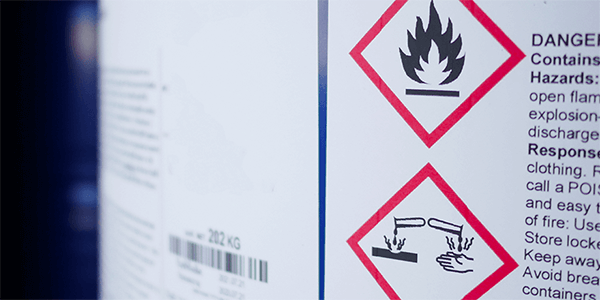GHS Label Information

Appendix C to the 2012 (OSHA 1910.1200) Hazard Communication Standard (HCS) specifies the mandatory "allocation of label elements." What this means is that this appendix specifies the information that must be included on a GHS label, including the standardized wording of that information.
The following are a few of the key sections from this appendix. This article is just an overview of appendix C. Please read this appendix for complete information.
Section C.2 states that for each hazard class and category that is applicable to a substance, the GHS label must include a signal word, hazard statement(s), pictogram(s), and precautionary statement(s) as specified in section C.4 of this appendix.
Section C.2.2.1 states that the text of all applicable hazard statements (provided in section C4) must be on the label, unless an exception is specified. The information described in italics in section C4 can be obtained from the Safety Data Sheet (SDS) and must be included as part of the hazard statement. For example, you must include the information specified by the text in italics in this statement: "causes damage to organs (state all organs affected) through prolonged or repeated exposure (state route of exposure if no other routes of exposure cause the hazard)". Hazard statements may be combined where appropriate to reduce the information on the label and improve readability, as long as all of the hazards are identified.
Section C.2.4.1 identifies the four types of precautionary statements that must be on each label, "prevention," "response," "storage," and "disposal." The specifics of these precautionary statements are given in section C4. The core part of the precautionary statement is presented in bold print in C4. This is the text, except if otherwise specifically excluded by the SDS, that must always be on the label. Where additional information is required, it is printed in plain text.
Section C.3.1 states that to prevent non-standardized information from creating a wide variation in the information on GHS labels and thus causing confusion, supplementary information on the label is limited to information that provides further detail and which does not contradict or cast doubt on the validity of the required standardized hazard information.
Section C4 of this appendix provides a table giving the mandatory signal words, hazard statements, pictograms and precautionary statements that must be used on GHS labels for 30 categories of hazards. Here is an example of the information provided in this table (bolding is below used as it is in section C4):
C.4.1 ACUTE TOXICITY - ORAL
Hazard category: 1
Signal Word: Danger
Hazard Statement: Fatal if swallowed
Pictogram: Skull & Crossbones
Precautionary Statements:
Prevention:
Wash ...thoroughly after handling. (...the chemical manufacturer, importer, or distributor is to specify the parts of the body to be washed after handling. They should be listed after the word "wash" on the GHS label.)
Do not eat, drink or smoke when using this product.
Response:
If swallowed: Immediately call a poison center/doctor/etc. (...the chemical manufacturer, importer, or distributor will specify the appropriate source of emergency medical advice. That information must be included on the GHS label.)
Specific treatment (see ...on this label)( ...provide first aid information from the supplemental first aid instruction.)
- if immediate administration of antidote is required. (You must include the information identified here in italics, if it applies to this chemical).
Rinse mouth.
Storage:
Store locked up
Disposal:
Dispose of contents/container to...
... in accordance with local/regional/national/international regulations (to be specified).
Making OSHA compliant GHS labels requires a label printer that has the versatility to print a variety of label sizes. Some chemicals may not require much information and can have smaller labels. Other chemicals, requiring more information, will need larger GHS labels. A DuraLabel printer gets the job done, saves your time and produces long-life, durable labels. Call us today and ask about DuraLabel printers for printing GHS labels.
Related Resources

What is HazCom? Your Guide to Chemical Labeling, GHS, & OSHA Standards
What Is OSHA’s Hazard Communication Standard (HazCom)? "HazCom" is short for "Hazard Communication," OSHA’s ...
Read
How DuraLabel Systems Improve GHS Labels for Compliance and Safety
How DuraLabel Printers Simplify GHS Labeling for Compliance and Safety In regulated industrial environments, ...
Read
Hazard Communication Solutions for a Safer Workplace
A faded label. A missing hazard symbol. An outdated SDS. These small details can trigger big problems in ...
Read.png)





